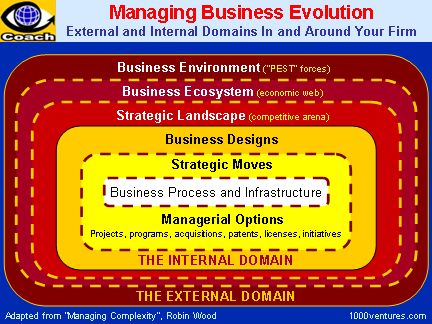
|
Two Varieties of Business
Spaces1 |
-
Old and Occupied
Business Space
– has a well-established order and congested with competitors
-
New and Unoccupied Business Space
– wild, unprotected, lots of opportunity, and lots of risk
|
|
Business Space Defined
Business Space, also referred to as Strategic
Landscape, is the playing field you occupy. The term "Business Space"
derives from the notion that firms occupy market positions that can be
delineated by a set of dimensions.
How much
shareholder wealth your company creates is determined by how much of the
business space your organization occupies and how valuable your position is.
Case Study
Cisco
Cisco Systems Inc. defined its business space
and market segments in three overlapping target areas:
-
Big corporations, educational institutions,
government agencies, and utilities who have complex networking needs that
involve multiple locations and several different types of computer systems
-
Small- and medium-scale enterprises (SMEs) who want their own Intranet data
networks, as well as connections to the Internet and intimate data links
with business partners
-
Information service companies that include telecommunication carriers,
Internet service providers, cable companies, and wireless communication
providers.
SPACE
Matrix Strategic Management Method
The Strategic Position & Action Evaluation matrix or short a SPACE matrix
focuses on strategy formulation
especially as related to the competitive position of an organization.
The SPACE matrix is a strategic management
tool used to analyze a company and determine what type of a strategy it
should undertake. It can also be used as a basis for other analyses, such as
the SWOT analysis,
BCG matrix
model, industry analysis, or assessing strategic alternatives
The SPACE matrix can be created using the following seven steps2:
-
Choose a set of variables to be used to gauge the
sustainable competitive advantage
(SCA), industry strength (IS), environmental stability (ES), and
financial strength (FS).
-
Rate individual factors using rating system specific to each dimension.
Rate
sustainable competitive
advantage (SCA) and environmental stability (ES) using rating scale
from -6 (worst) to -1 (best). Rate industry strength (IS) and financial
strength (FS) using rating scale from +1 (worst) to +6 (best).
-
Find the average scores for sustainable competitive advantage (SCA),
industry strength (IS), environmental stability (ES), and financial
strength (FS).
-
Plot values from step 3 for each dimension on the SPACE matrix on the
appropriate axis.
-
Add the average score for the sustainable competitive advantage (SCA)
and industry strength (IS) dimensions. This will be your final point on
axis X on the SPACE matrix.
-
Add the average score for the SPACE matrix environmental stability (ES)
and financial strength (FS) dimensions to find your final point on the
axis Y.
-
Find intersection of your X and Y points. Draw a line from the center of
the SPACE matrix to your point. This line reveals the type of strategy
the company should pursue.
|